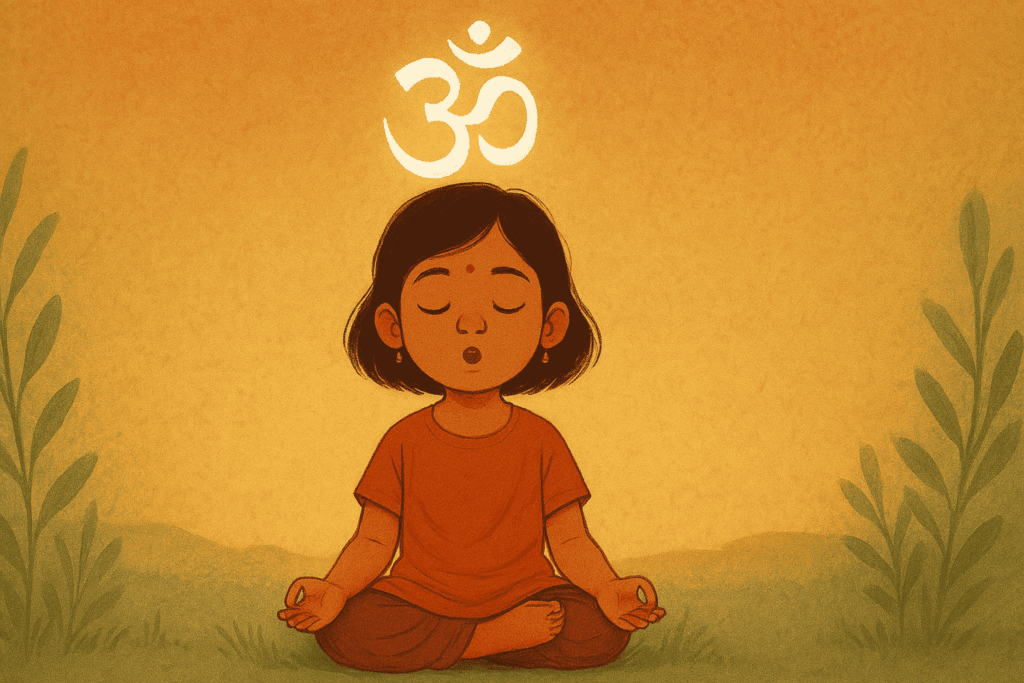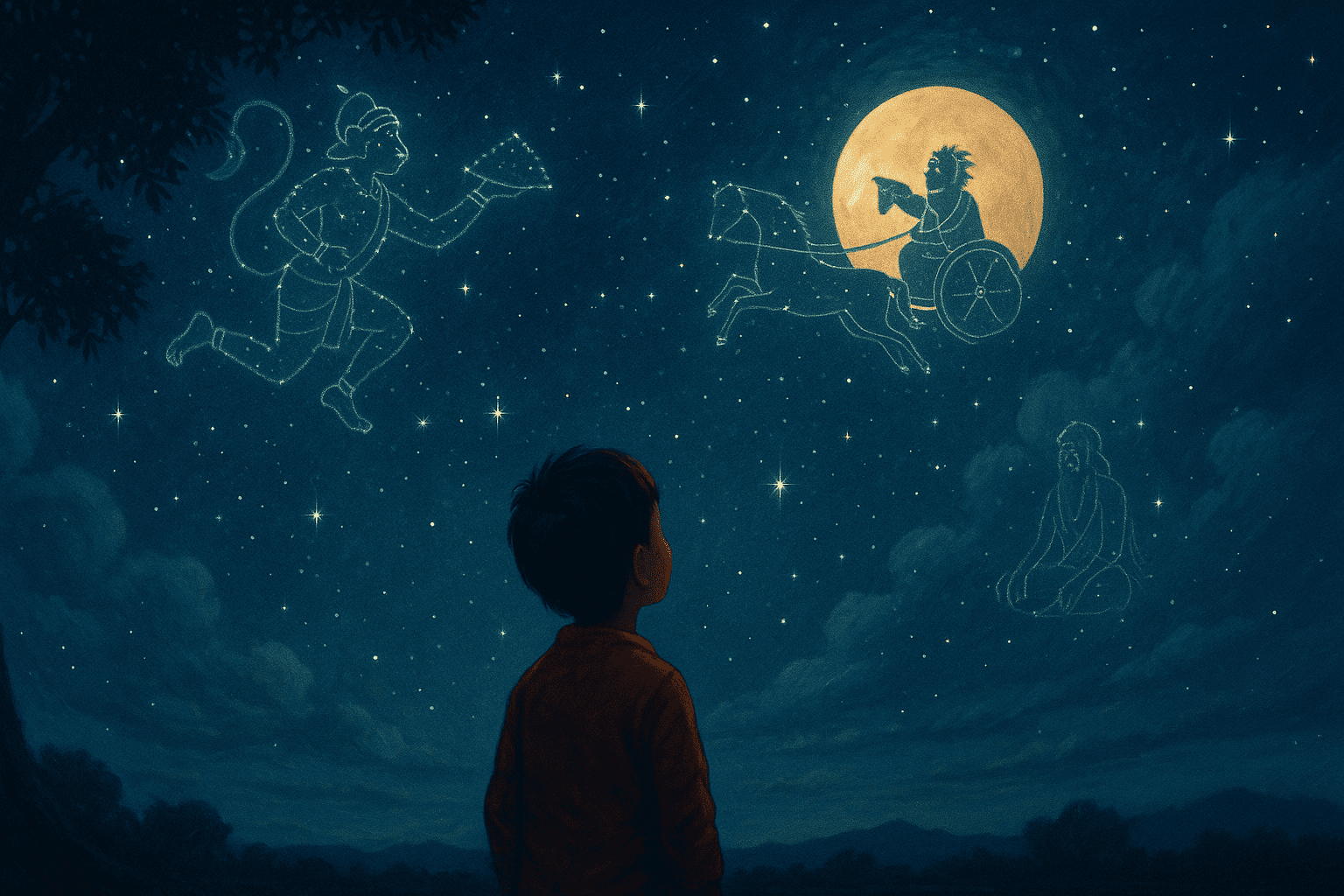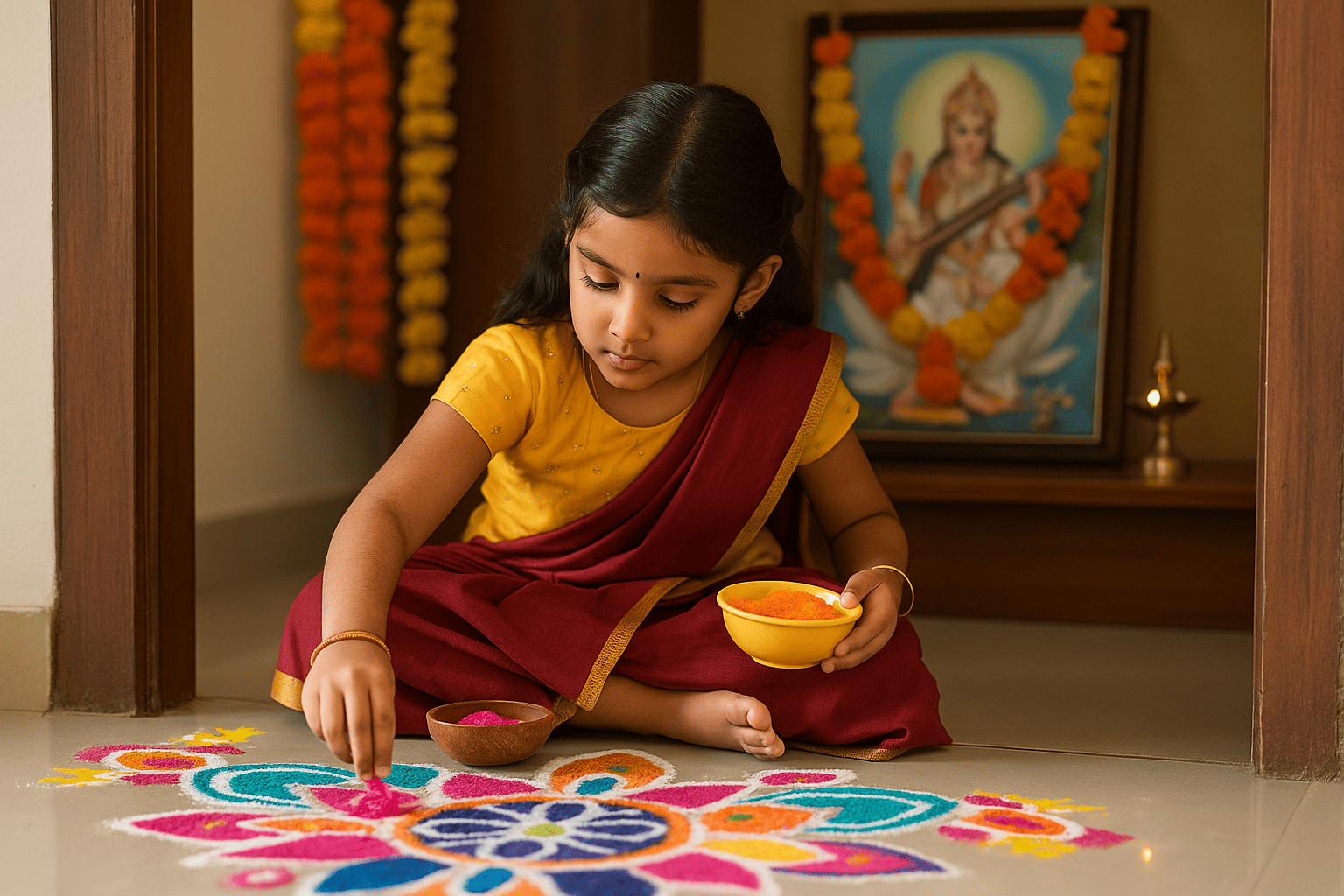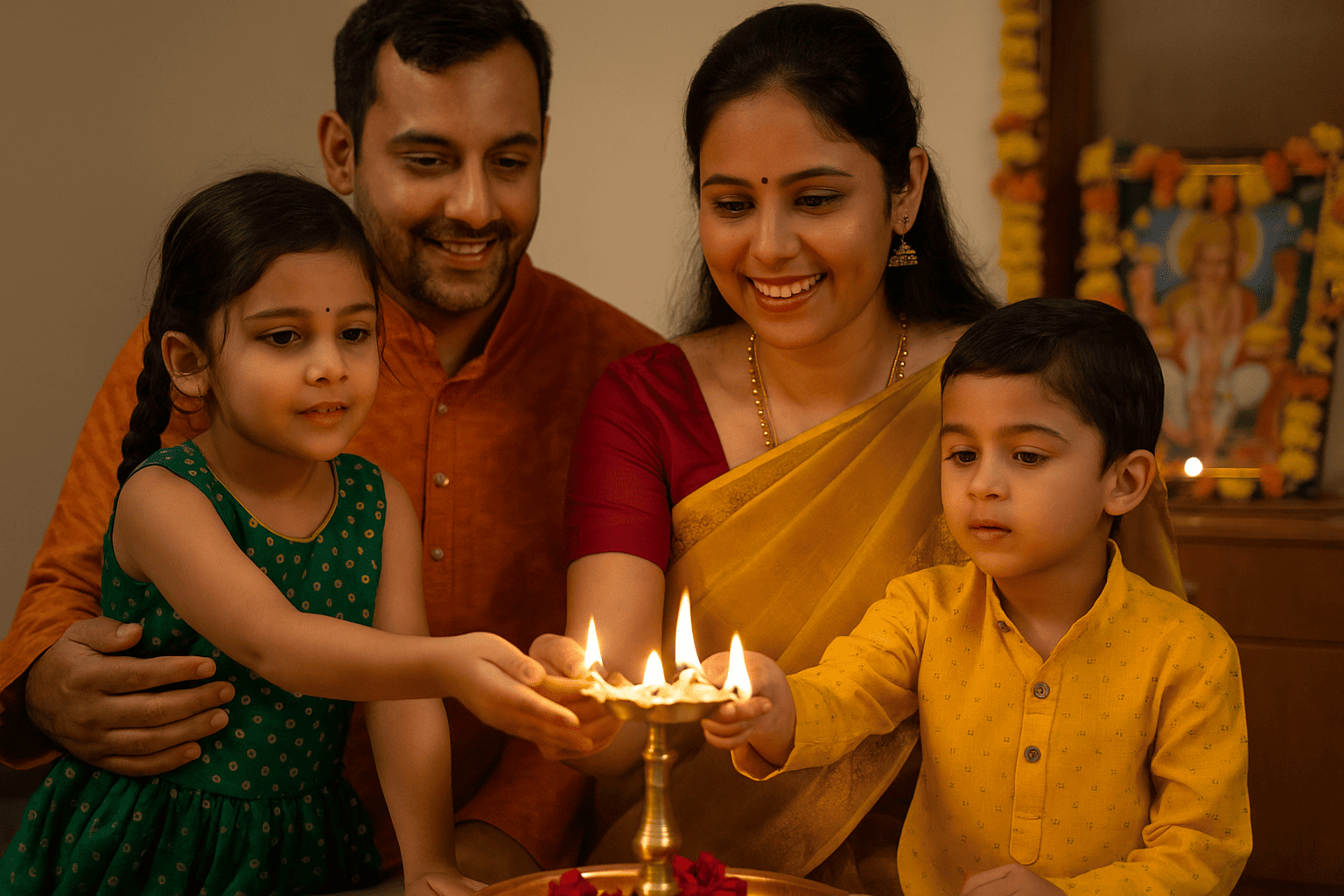

In the quiet corners of early dawn, as birds whisper their songs into the sky and a gentle hush still lingers in the air, there exists a sound more ancient than time itself—a vibration, a breath, a syllable that holds the mysteries of the universe. It’s not a word, not a chant, not a melody. It is Aum—the cosmic sound that breathes life into silence.
To the untrained ear, it may sound like just three letters—A, U, and M—spoken in harmony. But for those who listen with the heart, Aum becomes something more: a bridge between the seen and unseen, between the child’s curious gaze and the deep, still wisdom of the universe.
Long before the earth turned on its axis, before the sun first poured its golden light into the darkness, and before even time knew how to count its moments, there was only silence. Not an empty silence, but a full, breathing kind—a silence that was listening, waiting, knowing.
And then, from that silence, a vibration stirred.
Soft at first, like a ripple moving through still water. Then deeper, wider—like the sound of a distant drum slowly awakening. That was the first sound, the primal vibration. The universe’s very first heartbeat. It was not shouted, not spoken—it simply was.
That sound was Aum.
Not created by any mouth, not heard by any ear—it existed as pure vibration. The ancients believed that this sound didn’t come from the universe—it became the universe. Every atom, every star, every breath we take carries the echo of that original sound. It is the thread that weaves through all of existence.
Imagine a giant bell being struck gently in the vastness of space, its sound traveling endlessly, becoming light, becoming wind, becoming the shape of galaxies. That is Aum—not a word, but a wave. Not a chant, but a current of life.
Even now, when children close their eyes and chant “Aum,” they are not just repeating a sound—they are aligning themselves with this ancient pulse, this sacred rhythm that holds the stars in place and stirs the leaves on a tree.
To them, it may feel like play, or maybe peace. But in that simple sound lives something timeless. Something holy.
Philosophers and yogis across generations have spoken of this mystery. In the Mandukya Upanishad, one of the oldest spiritual texts in India, it is said that Aum is the past, the present, and the future—and also what lies beyond time. It is the essence of all that was, all that is, and all that will ever be.
What a wonder, then, that such an immense truth can be felt in something as simple as a child’s breath.
Aum does not belong to temples or sages alone. It lives in the hush of a forest at dusk. In the lullaby a mother hums. In the pause between lightning and thunder.
It lives in children too—in their questions, their laughter, their dreams. When they chant Aum, even if just once, they are singing with the stars. They are joining in the universe’s first song.
On the surface, Aum may seem like a single sound, simple and complete. But nestled within its vibration are three sacred syllables—A, U, and M—each with its own rhythm, its own breath, its own secret story to tell.
These aren’t just letters. They are the building blocks of life itself.
The first breath of Aum begins with A (pronounced “ahh”). It starts deep in the belly, rising like the sun over a sleepy horizon. This is the sound of beginnings—the cracking of a seed, the first cry of a newborn, the painter’s brush touching canvas for the first time.
“A” is the sound of creation.
In Hindu thought, it is linked to Brahma, the creator, who brings form to formlessness. When a child chants “ahh,” it is like watching a story unfold from the first page, watching the colors of life rush into the blank spaces of the world.
Children are natural creators—of games, stories, questions, and dreams. So it makes sense that their voices often echo with this energy. Every “once upon a time” carries the breath of “A.”
As the syllable flows forward, “A” rolls effortlessly into U (pronounced “ooh”). It travels upward, resonating in the chest, the heart’s own sacred space.
This is the sound of preservation, the breath that sustains. In Hinduism, it is associated with Vishnu, the protector of the universe, who maintains harmony and balance. “U” is the gentle hum of continuity—the lull of a rocking cradle, the rhythm of footsteps on a steady path, the harmony of a family gathered around the evening lamp.
Children know this sound in the security of routines, in warm hugs, in the quiet confidence of knowing the sun will rise again tomorrow. “U” reminds them that while life changes, there is also something stable, something that stays, something that holds them gently in its arms.
Finally, the sound closes with M (pronounced “mmm”). It hums through the lips and head, lingering in the stillness it leaves behind.
“M” is the sound of transformation, of closure, of returning to silence with grace. It is the whisper of the setting sun, the slow closing of a book, the peaceful breath that comes at the end of a long day.
In tradition, it represents Shiva, the transformer, the one who helps us shed the old so the new can be born. Children, too, are constantly transforming—growing taller, wiser, kinder. Their worlds shift and evolve each day, like clay in gentle hands. “M” honors that journey.
It is also the most meditative of the three sounds. When children linger in the “mmm,” they begin to feel not just the sound in their mouths, but the vibration in their bones, the quiet in their minds, the peace in their breath. It’s a soft landing into stillness.
Together, these three sounds—A, U, and M—form the arc of life itself.
Birth.
Being.
Becoming.
It’s like the sun rising, shining, and then setting—only to rise again. Or the stories we tell—beginning, unfolding, and ending—only to be told once more in new ways.
Aum is the sound of wholeness.
It is not just a chant. It is a journey. Every time a child chants Aum, they are not just saying something sacred—they are moving through the sacred itself. They are living the breath of the universe.
And perhaps the most magical thing?
They don’t need to understand all of this to feel it.
Even the smallest voice chanting Aum can carry the echo of the cosmos.
Even the simplest heart can hold the rhythm of the stars.
In a quiet village cradled by the curves of a winding river, time moved slowly—just the way the elders liked it. The breeze always carried the scent of mango blossoms, and the trees whispered secrets to those who listened.
Every evening, as the sun dipped low and painted the sky in saffron and rose, children gathered on a woven mat outside their ancestral home. It was their favorite time of day—not because of the fading sunlight, but because of Paati.
Meenakshi Paati had the kind of voice that felt like a song and a sigh at once. Her silver hair was always neatly tied, and her eyes held the shimmer of a thousand stories. She didn’t read from books. She didn’t need to. Her stories lived in her—the way rivers live in the land.
That evening, little Anaya sat closest to her, eyes round with curiosity.
“Paati,” she asked, tugging gently at her sari edge, “what is the sound the pujari says before lighting the lamp? It’s like… Auuummm?”
Paati chuckled softly, as if she’d been waiting for that question her whole life. “That sound, kanna, is Aum,” she said, closing her eyes for a moment. “It’s the oldest sound there ever was. It’s how the universe says hello.”
Anaya giggled. “The universe talks?”
“Oh yes,” Paati nodded. “It talks without words. Aum is its language. When you say it, it’s like your heart is bowing to something bigger than all of us.”
The other children leaned in closer. Even the breeze seemed to still.
Paati continued, her voice now almost a whisper, “When we chant Aum, we don’t just say it. We become part of something timeless. We chant with the rivers, with the winds, with the stars.”
That night, as the moon rose quietly above the palm trees, Anaya lay in bed. She whispered “Aum” into the dark, just once. Not loudly, not perfectly. Just softly.
And in that moment, something deep within her became very still. Like the river before dawn.
Children are naturally attuned to rhythm. They tap their feet without thinking, hum tunes in the middle of play, and repeat words just because they love the way they sound. Their world is filled with beats and patterns—heartbeat, footsteps, laughter, lullabies.
That’s why chanting Aum feels so instinctive to them. It doesn’t ask for perfection. It doesn’t demand silence or stillness. It simply invites them in—with open arms and a gentle hum.
Modern science is slowly catching up to what sages and seers knew thousands of years ago: sound heals. When a child chants “Aum,” the vibration travels through their body like a wave—calming their nervous system, slowing their breath, and settling their busy thoughts.
Studies show that chanting Aum can activate the vagus nerve, a key to emotional regulation and inner peace. For children, this means reduced anxiety, improved focus, and better sleep. But beyond the science, there’s something even more magical happening.
Aum becomes a sacred pause.
In a world filled with overstimulation—endless screens, noise, and movement—chanting offers children a moment to come back to themselves. To listen inward. To breathe. To be.
And because Aum is so simple, even the youngest ones can join in. No long verses to memorize. No difficult posture. Just breath, sound, and presence.
In that moment, something shifts.
The world softens.
The child quiets.
And the universe leans in—listening.
If one listens closely—not just with the ears but with the whole body—nature hums with the sound of Aum.
It’s not always obvious. It doesn’t shout or demand attention. But it’s there, quietly pulsing through the leaves, the rivers, the skies—like a secret melody only the soul can hear.
When a honeybee flutters from flower to flower, its gentle buzz isn’t just a sound of activity. It’s a soft, vibrating “mmm”, echoing the closing syllable of Aum. When ocean waves crash and retreat, they rise and fall in a rhythm not unlike “aaah-ooooh-ummm”—an endless breath between earth and sky. Even the wind, when it slips through the trees at dusk, carries long, drawn-out whispers that seem to chant in a language older than words.
Children are often the first to notice.
They stop to listen to the rustle of dry leaves or the purring of a cat. They mimic the owl’s call and sing with the rain. To them, nature is not separate—it’s alive, full of voice and vibration.
And so, when a child chants Aum, it’s not something apart from the world. It’s in harmony with what the world is already saying.
The forest doesn’t need a microphone. The river doesn’t need a prayer book. They simply are. Their song is Aum in its rawest form—vibration, flow, presence.
Sharing this perspective with children doesn’t require explanations. It simply takes a moment under a tree, or beside a stream, or on a windy balcony.
You could say to them, “Can you hear the Aum in the breeze?”
Or, “Close your eyes. Can you feel the world humming with you?”
Because once they notice it, they’ll begin to find Aum everywhere.
In birdsong.
In waterfalls.
In the hush just before a thunderstorm.
In their own breath.
And in that recognition, a deep connection blooms. One that says:
“You are part of this.”
“You belong.”
“You’re never really alone.”
Most of the time, children explore the outer world—running through fields, building forts, climbing trees, touching textures, tasting rain. Their senses are wide open, eager to take in everything the world has to offer.
But there’s another world waiting inside them, just as vast, just as beautiful. A world of feelings, of thoughts, of stillness and wonder. A world where questions bloom and imagination dances quietly in the shadows.
Aum is the bridge between these two realms.
When a child chants Aum, something magical happens. The sound begins deep in the belly, travels upward through the chest, and rises into the head—vibrating through the body like a river flowing home. The outer sound becomes an inner journey.
You can even invite children to notice it:
“Where do you feel the ‘A’? In your tummy?”
“Does the ‘U’ move through your heart?”
“Can you feel the ‘M’ tickling your lips or buzzing in your head?”
These questions aren’t just playful—they awaken a new kind of awareness. The sound is no longer something happening outside of them. It becomes something they are experiencing—inside their bodies, inside their breath, inside their being.
And slowly, they begin to understand:
Just like the wind moves through trees, Aum moves through them.
Just like rivers flow through land, peace flows through breath.
Just like stars light the night sky, stillness can light the heart.
The more they chant, the more natural this connection becomes. The space between outside and inside becomes softer, more fluid. A boundary turns into a bond.
They begin to see that the calmness of the early morning sky can exist in their mind. That the grounded strength of a mountain can be felt in their spine. That the joy of a laughing brook can echo in their chest.
In this way, Aum gently teaches them that the sacred is not only in temples or rituals—it is also in them.
Their breath is a temple.
Their voice is a prayer.
Their silence is a sacred space.
And with every chant, they step a little closer to that truth.
There is a moment—small, quiet, easy to miss—that arrives right after the final syllable of Aum fades away.
It’s the pause.
The hush.
The stillness that follows the sound.
And in that silence lies a mystery far deeper than the chant itself.
After the lips close gently on the final “mmm,” and the vibration slowly dissolves into the air, there’s a space where everything becomes soft and still. It’s not empty. It’s full—full of presence, full of peace, full of something that can’t quite be named.
This silence is not like any other silence. It’s not awkward or lonely or cold. It’s the kind of silence that hugs you from the inside. The kind that makes even a child sit a little straighter, breathe a little slower, smile a little more softly.
In ancient texts like the Mandukya Upanishad, this sacred stillness is given a name—Turiya—the fourth state of consciousness, beyond waking, dreaming, and deep sleep. It’s the space where one meets the Self. Not the self who wants or worries, but the self who is.
Of course, a child doesn’t need to know that name.
They only need to feel what comes after Aum:
A sense of calm.
A feeling of safety.
A quiet joy that lingers like the scent of sandalwood after the flame goes out.
For young ones, this might look like closing their eyes and sitting peacefully for a moment longer. Or taking a deep breath and slowly opening their eyes with a smile. For some, it might even feel like floating gently inside a cloud—light, soft, free.
That silence becomes a mirror. It reflects back their emotions, their energy, their truth. And in that reflection, they feel heard—even without speaking.
When children are taught to value this silence—to sit with it, to trust it—they begin to find comfort in stillness. They no longer need constant noise or stimulation. They begin to enjoy the quiet between things—the pause between thoughts, the break between words, the space between busy moments.
And most importantly, they begin to understand something that even adults sometimes forget:
You don’t always have to do.
Sometimes, it is enough just to be.
And in that sacred space after Aum…
They are exactly that.
Present. Whole. Held.
In the rush of daily life—school bags to pack, breakfast to eat, toys to tidy, lessons to learn—there is something deeply healing about a simple ritual. Especially one that begins with a breath and ends in stillness.
Aum, in its simplicity, becomes the perfect companion for a child’s day. It doesn’t need much space. It doesn’t need special tools or ceremonies. Just a quiet corner, an open heart, and a moment of presence.
It can begin as gently as lighting a small lamp. Or folding hands in front of a picture of Ganesha or a simple diya. A parent or grandparent softly chants “Aum” three times, and the child joins in, their voice blending with the warmth of the morning.
No need for long prayers.
No pressure to sit still like a statue.
Just the joy of sound. The joy of being together.
Over time, this small act becomes something the child looks forward to. A sacred rhythm. A safe moment of connection.
And the beauty of Aum is that it can meet the child wherever they are. Here are a few ways it can gently find its place in their day:
It doesn’t have to be a long practice. Even one minute of chanting can change the energy of an entire day.
And sometimes, it happens spontaneously.
A child playing with their toys might hum a soft “mmmm.” A moment of frustration might dissolve into a breath and a chant. A car ride, instead of silence or screen time, turns into a space of shared Aums between siblings and parents.
These aren’t rules. They’re reminders—that peace is always nearby, waiting to be invited in.
And as these moments add up, something quiet and powerful begins to grow inside the child:
A sense of steadiness.
A trust in their own breath.
An unspoken relationship with something higher, something gentle, something divine.
This is how Aum moves from a sound to a companion—one that walks with the child, not just through rituals, but through life.
In the heart of every prayer, nestled within sacred chants and whispered mantras, there is almost always one sound that leads the way—Aum.
It is the doorway, the first step, the golden key that unlocks the space between us and the Divine.
In Hindu tradition, Aum is not just a symbol of the Divine—it is the Divine. It represents the infinite, the eternal, the unknowable presence that many call Brahman—that which is beyond all form, yet present in all things.
But how do we explain something so vast to a child?
The answer is—we don’t need to.
Because children already know.
They know what it means to feel safe in a parent’s arms.
To trust the sun will rise again tomorrow.
To talk to the stars, or smile at the moon, or believe that someone, somewhere, is always listening.
For them, the Divine is not a concept. It’s a feeling.
And Aum becomes their way to speak to it.
When children chant Aum, they may not be thinking of Shiva or Vishnu or Devi by name. But they are reaching out. They are connecting—to love, to light, to something bigger than themselves that still feels close and comforting.
Some may picture Ganesha, with his round belly and kind eyes, sitting beside them as they chant. Others may feel the presence of a warm golden light, or hear a soft inner whisper saying, “You are loved. You are safe.”
Aum doesn’t ask for a specific image. It leaves room for wonder.
It allows each child to discover the Divine in their own way.
And this is why so many mantras begin with Aum:
Each mantra becomes a bridge, and Aum is the first stone in that bridge. It prepares the heart. It clears the mind. It opens the space for devotion to arise—not as a duty, but as a dance.
Parents and caregivers can help nurture this by allowing children to explore spirituality with openness and joy. There is no need for heavy theology. Just small moments—a shared chant, a glowing diya, a quiet question before sleep.
“Do you feel anyone listening when you chant?”
“Where do you think Aum goes when we send it out into the world?”
In these tender moments, a child begins to form their own relationship with the Divine—not one that is borrowed or imposed, but one that is deeply personal.
And Aum, soft and timeless, becomes their sacred thread. A sound they can carry anywhere. A prayer they don’t need to memorize, because it’s already part of who they are.
Years passed like the turning pages of a well-loved story.
Anaya, the little girl who once sat cross-legged at her Paati’s feet by the river, was now a mother. Life had changed in many ways—taller buildings, faster days, glowing screens. But some things remained constant. The early morning light still felt sacred. The smell of incense still calmed her heart. And the sound of Aum still echoed within her, soft and strong, like the river she once watched in silence.
One evening, as golden dusk settled over her home, her young son tugged at her hand.
“Amma,” he said, “can we do the Aum thing again?”
She smiled. Not because it was a routine, but because it was a remembering.
They sat together on the floor. No elaborate altar, no fanfare. Just a flickering diya, the hum of birds outside, and two steady breaths ready to meet the sacred.
Their voices rose, gently at first.
Aaaa… Oooo… Mmmm…
The chant wrapped around them like a warm shawl—old and familiar, yet new every time. And as the final “mmm” melted into stillness, the room felt full. Not with sound, but with presence.
Anaya glanced at her son. His eyes were closed. His face peaceful. And for a moment, she saw not just a child, but a soul—one that remembered the same sound the stars remember.
Because that’s what Aum does.
It becomes a part of you.
Not just something you chant, but something that lives in your breath, rises with your courage, rests in your calm.
It’s in the way a child learns to pause before reacting.
In the way they smile for no reason after chanting.
In the way they begin to carry a quiet strength inside them.
And over time, that simple sound—chanted again and again in love—becomes an echo that never fades.
It lives in their voice.
In their thoughts.
In their choices.
In the spaces between their words.
The echo within.
The journey of Aum is not one of instruction, but of invitation.
We don’t teach children to chant as an obligation. We offer it to them like we would a flower, a story, or a lullaby. With gentleness. With wonder. With trust.
Because somewhere, deep within, they already know.
They know how to listen to the wind.
They know how to speak without words.
They know how to become one with the sound that birthed the stars.
All we have to do is help them remember.
Aum is not the destination. It is the path. A soft, golden path that leads inward, upward, outward—all at once. And in every quiet step, children grow not just in mind, but in spirit.
They grow into the sound.
They grow into the silence.
They grow into something whole.
And the universe listens.
And chants back.







